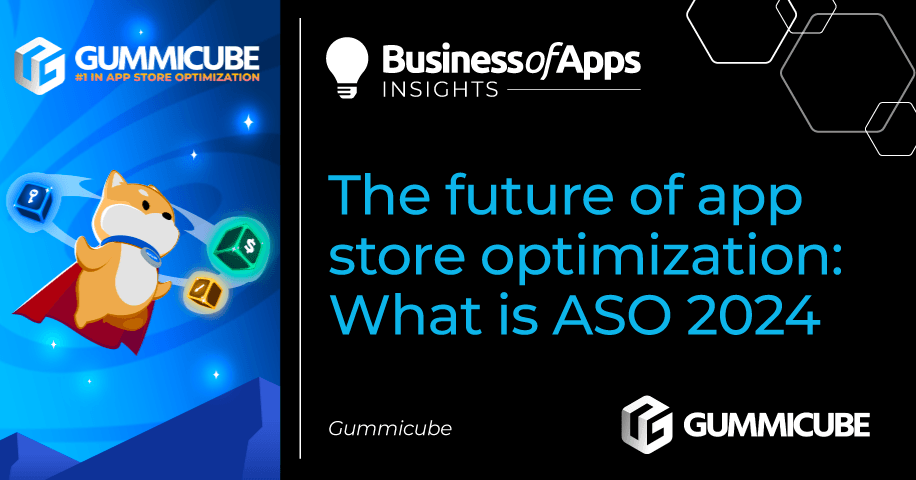App Store Optimization (ASO) finds its roots in 2010 when Gummicube revolutionized app discovery across the Apple App Store and Google Play Store. Initially, ASO solely concentrated on enhancing an app’s visibility through optimized keywords, store creatives, and descriptions. But, if you’re still looking at ASO through that lens alone, you might be missing out, hindering your ASO strategy’s effectiveness.
ASO today and beyond demands a holistic approach, aiming to magnify app visibility, conversion rates, and engagement within top-tier app stores like the App Store and Google Play Store.
The game-changer? The emphasis on engagement. While visibility and conversion remain crucial, both Apple and Google now prioritize user engagement post-installation. Inactive users equate to lost revenue. For marketers, optimizing the complete user acquisition and engagement journey, and cultivating sustainable monetization behaviors is fundamental to achieving success in app stores.
Adapting an ASO strategy is like navigating dynamic city streets – adjusting to new store features and OS changes that create twists and turns along the way. To gauge the future trajectory of ASO, it’s vital to understand fundamental best practices while keeping an eye on recent feature releases from Apple and Google.
ASO in the past: A Fresh perspective for the future
Before delving into the future, let’s rewind a bit. Exploring the foundational elements that shaped ASO — metadata optimization, conversion rate enhancements, and leveraging user reviews — offers invaluable insights into the evolving landscape of ASO.
Core ASO components we know
App Keyword Optimization or Metadata Optimization involves fine-tuning metadata like titles, subtitles, and descriptions. Why? To aid app stores in efficiently crawling and indexing your app. Strategic keyword selection helps determine your app’s visibility and position in user searches within the app stores.
App conversion rate optimization (CRO) is the backbone of ASO. Refining store listing elements — screenshots, app title, feature graphics, and videos — powers up download conversions. Improved conversions not only elevate keyword rankings but also bolster overall downloads and streamline marketing expenses.
Mobile app A/B Testing examines various store listing elements, such as creatives or descriptions, to pinpoint the most effective ones. The focus? To spike the rate at which users download your app post-discovery. Apple’s Product Page Optimization and Google’s Store Listing Experiments are two native platforms provided to developers so that they can leverage the power of A/B testing different listing assets. To take it a step further, developers can opt to use advanced app A/B testing tools like Splitcube that provide an even more comprehensive look into specific assets that contribute to growth.
Ratings and reviews hold immense sway over app visibility and user decisions. Users tend to hesitate with apps rated below 3.8 stars. Plus, since February 2023, Google Play’s initiative to fortify top charts accentuates the importance of encouraging reviews and ratings – they have set a “…minimum rating bar of 3.0 stars to improve top charts.”
Your playbook for the new app ecosystem [webinar]
The app stores have been cracked open. Savvy teams are already capitalizing by implementing App2Web and Web2App strategies. Join Paddle’s Lucas Lovell to discover smarter billing tactics.
Register nowPro tip: Never overlook addressing negative reviews. Not only do they appease users, but they also safeguard your app against potential uninstallations.
The boosters that elevate ASO
Among the strategies at your disposal, Apple Search Ads and Google Ads reign supreme in the realm of ASO. These paid media platforms are your golden tickets, allowing app store algorithms to competitively rank your app among high-volume search terms. When integrated seamlessly with ASO, they form a symbiotic relationship, working to improve an app’s keyword rankings, amplify download volumes, and optimize ROI.
Apple Search Ads and Google Ads possess a unique prowess — they strategically position your app amidst the competitive landscape of search results. Harnessing these channels alongside ASO serves as a catalyst, not only for immediate gains but also for establishing a sustained competitive edge in the ever-evolving app market.
Read more here to learn about how ASO can help your business.
The underrated heroes of ASO
While the spotlight often shines on the big players, let’s not overlook the unsung heroes. Deep linking, for instance, is a potent yet underutilized aspect that significantly influences discoverability and user interaction beyond traditional app store searches.
Deep linking: A Gateway to enhanced user interaction
Deep Linking guides users directly to relevant in-app content. Apple and Google each have their unique approach — Universal Links for Apple and Android App Links for Google.
For Apple’s ecosystem, leveraging Universal Links allows Apple to index your content. This indexation displays your content and features to users using Spotlight to search on their iPhones. Think of a user searching ‘travel to San Francisco’ — Universal Links could show flight options if your app offers flight tickets.
In the Android ecosystem, Android App Links are invaluable, enabling Google to index content within your app. Once indexed, your app appears in Google Search results, providing it with web SEO potential for users who don’t directly search in the Google Play store for certain app features.
Advantages of deep linking
- Boosted downloads: Enhanced discoverability outside the App Store leads to increased organic downloads. Additionally, iOS users’ Spotlight searches may display your content even if the app isn’t installed on their device.
- Enhanced engagement: Acting as subtle reminders to users about accessed content, deep links combat the fleeting nature of app interactions, aiding in retention efforts.
- Improved user experience: By seamlessly connecting users to desired content, deep linking fosters personalized interactions. Insights gained from deep links assist marketers in refining user journeys continuously.
- Brand visibility: Maintaining a presence in related searches serves as a constant reminder of your brand and your app’s relevance, especially among undecided users, significantly increasing your share of attention. Even established brands must focus on attracting new users, not solely catering to those intending to engage with their apps.
Advantages of Siri Suggestion and Spotlight Search
Our latest post covering iOS 17 explains the substantial enhancements to how your app can be discovered outside the App Store. Apple’s Spotlight and Siri Shortcuts provide developers with new means to link to specific features within their apps. Developers can even define specific phrases activating features within the app upon user demand.
Apple’s considerable focus on refining Spotlight and Siri highlights their relevance in ASO, hinting at the store’s future. Both Apple and Google aim to extend their stores throughout the internet and app experience with an increasing number of downloads to be expected from initial discoveries outside the App Store and Play Store.
Siri Shortcuts present fresh opportunities for developers, potentially bolstering user retention, usage, and rediscovery of apps. These shortcuts empower users to expedite routine tasks like app searches, bookings, or customized orders.
Spotlight Search showcases relevant app links in response to specific queries. For instance, searching ‘coupons’ yields apps targeting ‘coupons’ within their design. Additionally, apps installed on user devices featuring deep-linked keywords appear in these search results.
Highlighting the significance of maximizing discoverability potential, deep linking, Siri Shortcuts, and Spotlight emerge as highly recommended strategies to fortify developers’ App Store Optimization approaches. By leveraging these features, developers enhance user experiences, driving both discoverability and re-engagement, solidifying their presence within the iOS ecosystem.
ASO future, embracing engagement’s significance
Looking ahead, the emphasis on user engagement within the app ecosystem becomes increasingly pronounced. In-app events, promotional content, and in-app notifications emerge as pivotal tools shaping the future of ASO, directly influencing user retention and app visibility.
How In-App Events and Promotional Content impact engagement
Both Apple and Google underscore the importance of engagement by incorporating In-App Events (IAE) and Promotional Content (PC) into their store experiences.
In-App Events (IAE) serve as promotions that drive users directly into your app, showcasing new features, live events, exclusive previews, or special offers. Apple highlights these events across devices, amplifying discoverability, engagement, and retention.
Promotional Content (PC) on Google Play mirrors IAE on the App Store. These eye-catching banners within app listings serve as gateways to limited-time events or new content releases, reigniting interest among both new and returning users.
Not leveraging these events and content can render your app invisible. A well-executed campaign appeals to users across various engagement stages, whether welcoming new users, engaging loyal customers, or reigniting past interactions.
The App Store and Play Store focus on presenting users with what’s new and exciting TODAY, and these tools provided by both stores help developers keep their apps fresh and appealing.
The value of in-app notifications on engagement
After recognizing the pivotal role of engagement in ASO, integrating in-app notifications into your strategy becomes indispensable.
Enhancing user engagement with in-app notifications establishes a direct communication channel with your app’s user base. Thoughtfully crafted notifications, highlighting promotions, discounts, and products, act as compelling calls to action. Beyond mere information dissemination, these notifications actively engage users, sparking their curiosity and interest.
You can enhance your in-app notification strategy by implementing A/B testing to pinpoint what triggers user engagement most effectively. Given the swift changes in user behavior and preferences, A/B testing facilitates real-time adaptations, dynamically capturing users’ attention precisely when they’re most receptive.
The evolution of ASO
As the app industry matures, adapting your ASO strategies becomes essential. New opportunities from Apple and Google act as critical guiding elements, signaling the need for continual adaptation and optimization. These elements play a defining role in elevating an app’s prominence within a crowded marketplace and underline the necessity for ongoing innovation.
Furthermore, the shift towards optimization both pre and post-download emerges as a crucial progression in every ASO strategy. It’s about consistently enhancing the entire user experience, ensuring sustained engagement and retention beyond the installation phase. Embracing this holistic approach becomes essential in building a foundation for long-term app success in the ever-evolving app ecosystem.
In summary, the future of App Store Optimization lies in a comprehensive approach that not only optimizes initial visibility but also fosters continuous interaction and enriches user experiences throughout the app’s lifecycle. As the app market continues to evolve, adapting to new tools and strategies while prioritizing user engagement will be the cornerstone of successful ASO practices.
Take your mobile app marketing to the next level in 2024 with the ASO experts at Gummicube today!











